Implementing CSR Activities for Sustainable Objectives Report
VerifiedAdded on 2019/12/18
|22
|5059
|1265
Report
AI Summary
This report delves into the implementation of Corporate Social Responsibility (CSR) activities within the Hartmann organization to meet sustainable objectives. It begins with an introduction to CSR, emphasizing its importance in balancing business operations with environmental and social welfare. The report outlines project aims and objectives, including identifying CSR activities, analyzing their impact, and recommending improvements. A project management plan, including scope, timeframes, communication strategies, and deliverables, is presented. The work breakdown structure and Gantt chart provide a detailed timeline for project completion. The research methodology involves both qualitative and quantitative research methods to gather data, followed by data analysis and recommendations for enhancing CSR activities. A reflective study on the value of CSR activities for a sustainable organization concludes the report, highlighting the significance of CSR in today's business environment.
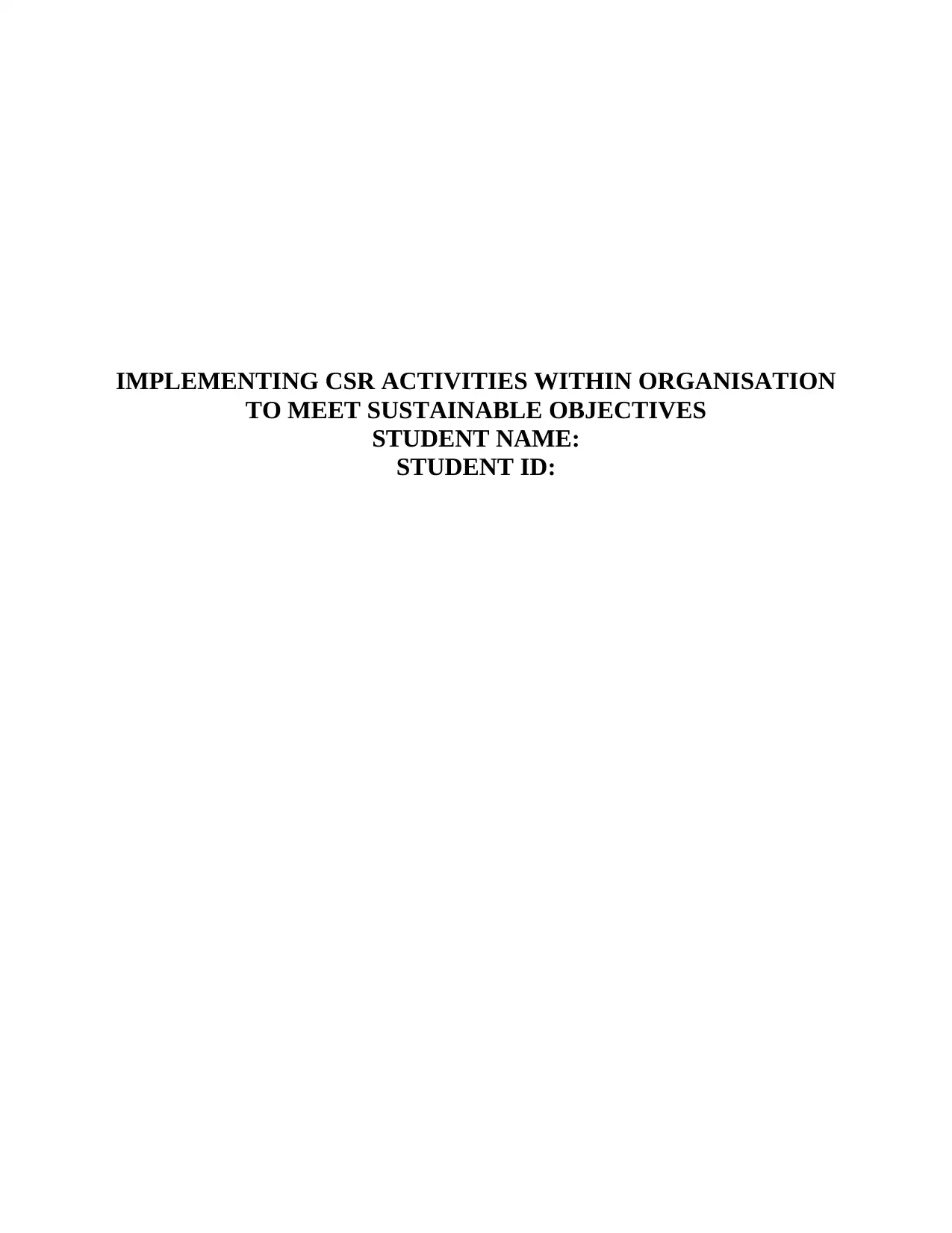
IMPLEMENTING CSR ACTIVITIES WITHIN ORGANISATION
TO MEET SUSTAINABLE OBJECTIVES
STUDENT NAME:
STUDENT ID:
TO MEET SUSTAINABLE OBJECTIVES
STUDENT NAME:
STUDENT ID:
Paraphrase This Document
Need a fresh take? Get an instant paraphrase of this document with our AI Paraphraser
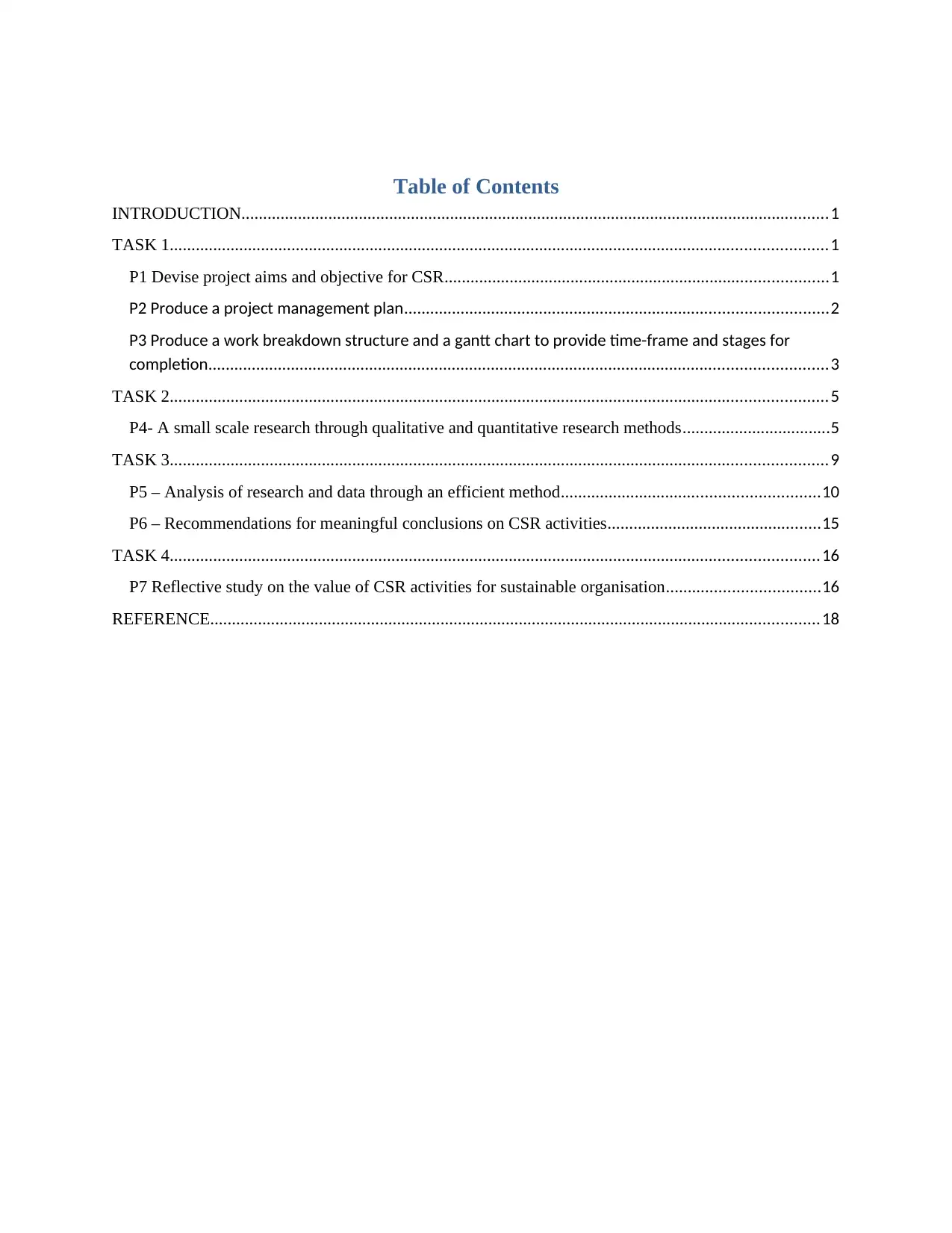
Table of Contents
INTRODUCTION.......................................................................................................................................1
TASK 1.......................................................................................................................................................1
P1 Devise project aims and objective for CSR........................................................................................1
P2 Produce a project management plan.................................................................................................2
P3 Produce a work breakdown structure and a gantt chart to provide time-frame and stages for
completion..............................................................................................................................................3
TASK 2.......................................................................................................................................................5
P4- A small scale research through qualitative and quantitative research methods..................................5
TASK 3.......................................................................................................................................................9
P5 – Analysis of research and data through an efficient method...........................................................10
P6 – Recommendations for meaningful conclusions on CSR activities.................................................15
TASK 4.....................................................................................................................................................16
P7 Reflective study on the value of CSR activities for sustainable organisation...................................16
REFERENCE............................................................................................................................................18
INTRODUCTION.......................................................................................................................................1
TASK 1.......................................................................................................................................................1
P1 Devise project aims and objective for CSR........................................................................................1
P2 Produce a project management plan.................................................................................................2
P3 Produce a work breakdown structure and a gantt chart to provide time-frame and stages for
completion..............................................................................................................................................3
TASK 2.......................................................................................................................................................5
P4- A small scale research through qualitative and quantitative research methods..................................5
TASK 3.......................................................................................................................................................9
P5 – Analysis of research and data through an efficient method...........................................................10
P6 – Recommendations for meaningful conclusions on CSR activities.................................................15
TASK 4.....................................................................................................................................................16
P7 Reflective study on the value of CSR activities for sustainable organisation...................................16
REFERENCE............................................................................................................................................18
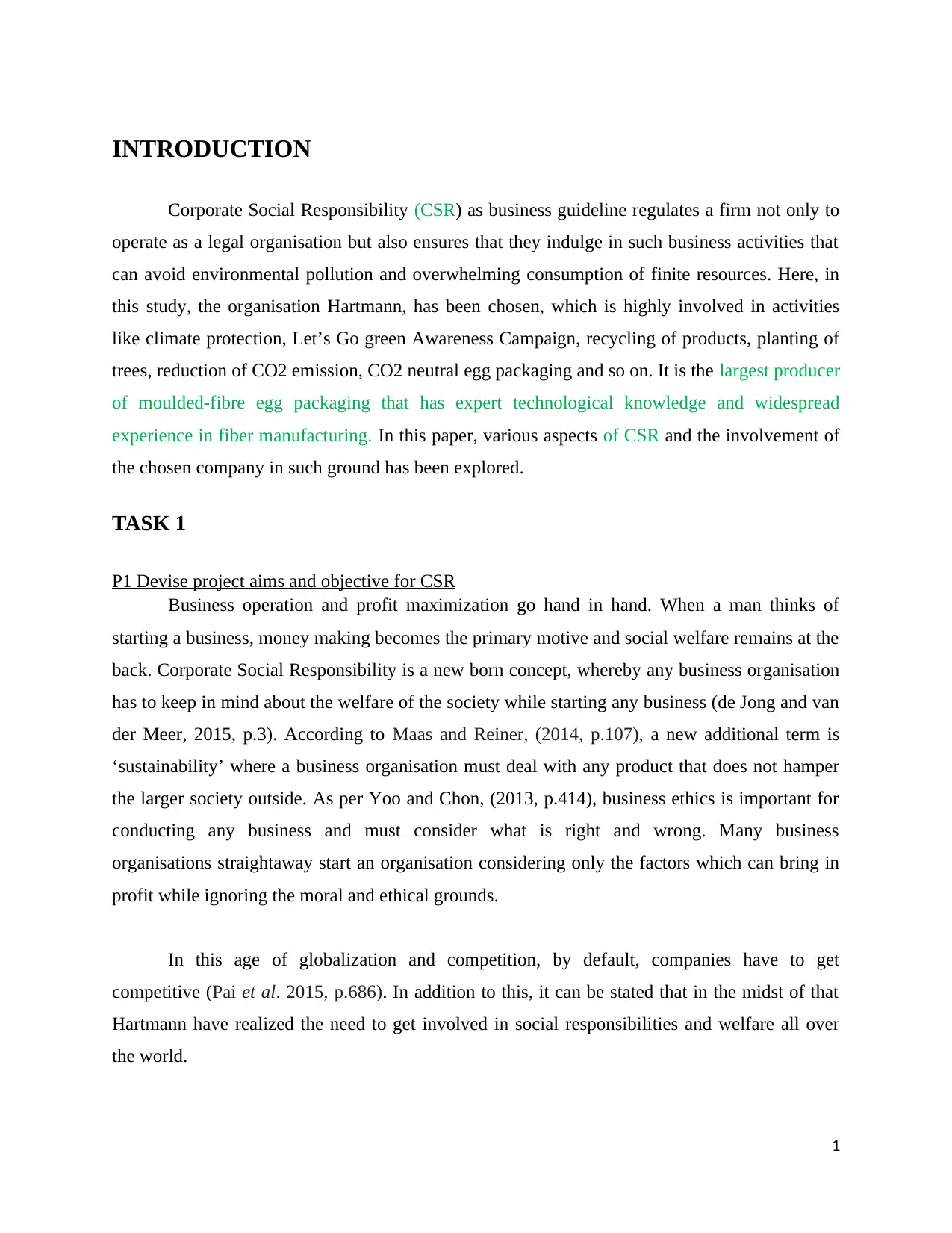
INTRODUCTION
Corporate Social Responsibility (CSR) as business guideline regulates a firm not only to
operate as a legal organisation but also ensures that they indulge in such business activities that
can avoid environmental pollution and overwhelming consumption of finite resources. Here, in
this study, the organisation Hartmann, has been chosen, which is highly involved in activities
like climate protection, Let’s Go green Awareness Campaign, recycling of products, planting of
trees, reduction of CO2 emission, CO2 neutral egg packaging and so on. It is the largest producer
of moulded-fibre egg packaging that has expert technological knowledge and widespread
experience in fiber manufacturing. In this paper, various aspects of CSR and the involvement of
the chosen company in such ground has been explored.
TASK 1
P1 Devise project aims and objective for CSR
Business operation and profit maximization go hand in hand. When a man thinks of
starting a business, money making becomes the primary motive and social welfare remains at the
back. Corporate Social Responsibility is a new born concept, whereby any business organisation
has to keep in mind about the welfare of the society while starting any business (de Jong and van
der Meer, 2015, p.3). According to Maas and Reiner, (2014, p.107), a new additional term is
‘sustainability’ where a business organisation must deal with any product that does not hamper
the larger society outside. As per Yoo and Chon, (2013, p.414), business ethics is important for
conducting any business and must consider what is right and wrong. Many business
organisations straightaway start an organisation considering only the factors which can bring in
profit while ignoring the moral and ethical grounds.
In this age of globalization and competition, by default, companies have to get
competitive (Pai et al. 2015, p.686). In addition to this, it can be stated that in the midst of that
Hartmann have realized the need to get involved in social responsibilities and welfare all over
the world.
1
Corporate Social Responsibility (CSR) as business guideline regulates a firm not only to
operate as a legal organisation but also ensures that they indulge in such business activities that
can avoid environmental pollution and overwhelming consumption of finite resources. Here, in
this study, the organisation Hartmann, has been chosen, which is highly involved in activities
like climate protection, Let’s Go green Awareness Campaign, recycling of products, planting of
trees, reduction of CO2 emission, CO2 neutral egg packaging and so on. It is the largest producer
of moulded-fibre egg packaging that has expert technological knowledge and widespread
experience in fiber manufacturing. In this paper, various aspects of CSR and the involvement of
the chosen company in such ground has been explored.
TASK 1
P1 Devise project aims and objective for CSR
Business operation and profit maximization go hand in hand. When a man thinks of
starting a business, money making becomes the primary motive and social welfare remains at the
back. Corporate Social Responsibility is a new born concept, whereby any business organisation
has to keep in mind about the welfare of the society while starting any business (de Jong and van
der Meer, 2015, p.3). According to Maas and Reiner, (2014, p.107), a new additional term is
‘sustainability’ where a business organisation must deal with any product that does not hamper
the larger society outside. As per Yoo and Chon, (2013, p.414), business ethics is important for
conducting any business and must consider what is right and wrong. Many business
organisations straightaway start an organisation considering only the factors which can bring in
profit while ignoring the moral and ethical grounds.
In this age of globalization and competition, by default, companies have to get
competitive (Pai et al. 2015, p.686). In addition to this, it can be stated that in the midst of that
Hartmann have realized the need to get involved in social responsibilities and welfare all over
the world.
1
⊘ This is a preview!⊘
Do you want full access?
Subscribe today to unlock all pages.

Trusted by 1+ million students worldwide
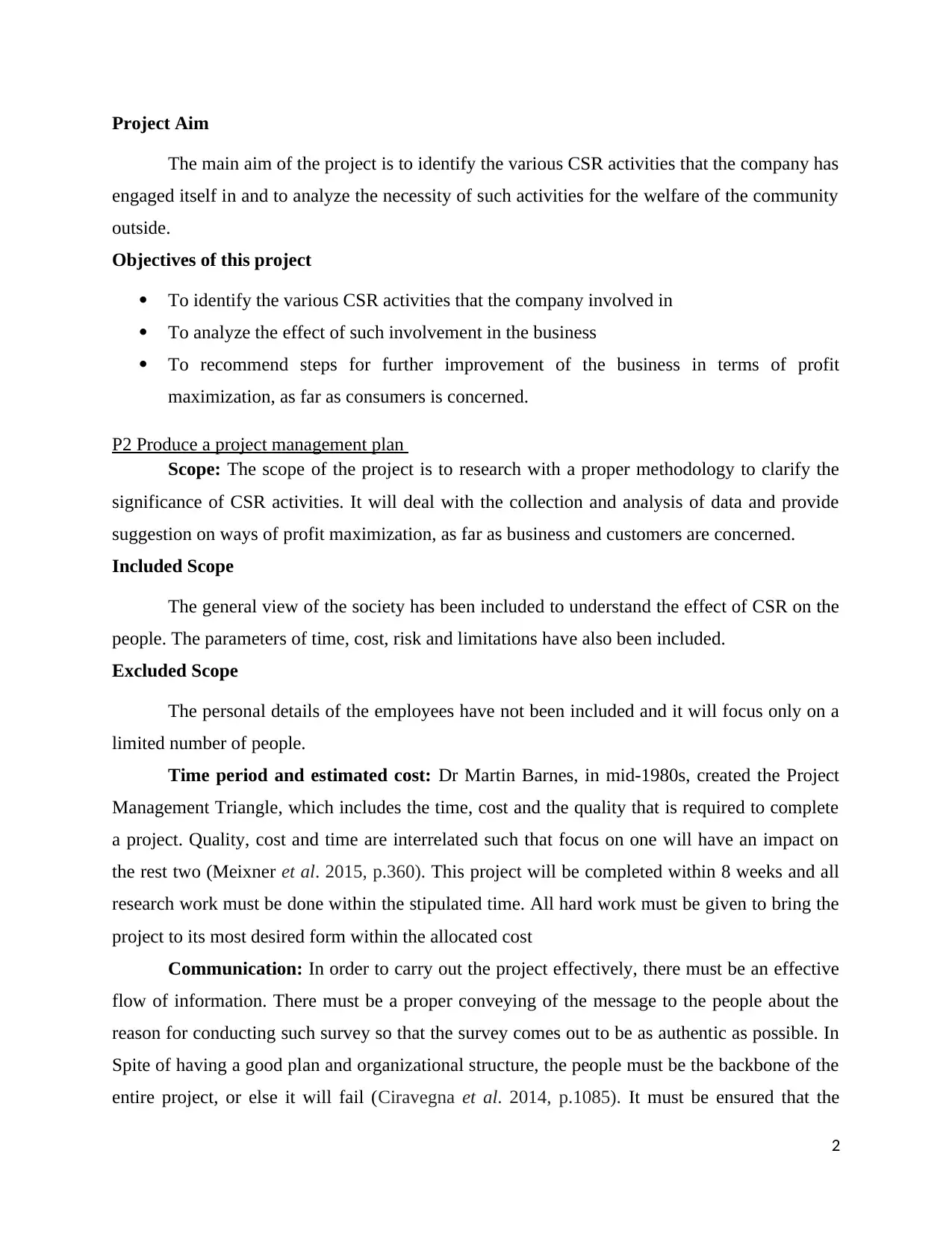
Project Aim
The main aim of the project is to identify the various CSR activities that the company has
engaged itself in and to analyze the necessity of such activities for the welfare of the community
outside.
Objectives of this project
To identify the various CSR activities that the company involved in
To analyze the effect of such involvement in the business
To recommend steps for further improvement of the business in terms of profit
maximization, as far as consumers is concerned.
P2 Produce a project management plan
Scope: The scope of the project is to research with a proper methodology to clarify the
significance of CSR activities. It will deal with the collection and analysis of data and provide
suggestion on ways of profit maximization, as far as business and customers are concerned.
Included Scope
The general view of the society has been included to understand the effect of CSR on the
people. The parameters of time, cost, risk and limitations have also been included.
Excluded Scope
The personal details of the employees have not been included and it will focus only on a
limited number of people.
Time period and estimated cost: Dr Martin Barnes, in mid-1980s, created the Project
Management Triangle, which includes the time, cost and the quality that is required to complete
a project. Quality, cost and time are interrelated such that focus on one will have an impact on
the rest two (Meixner et al. 2015, p.360). This project will be completed within 8 weeks and all
research work must be done within the stipulated time. All hard work must be given to bring the
project to its most desired form within the allocated cost
Communication: In order to carry out the project effectively, there must be an effective
flow of information. There must be a proper conveying of the message to the people about the
reason for conducting such survey so that the survey comes out to be as authentic as possible. In
Spite of having a good plan and organizational structure, the people must be the backbone of the
entire project, or else it will fail (Ciravegna et al. 2014, p.1085). It must be ensured that the
2
The main aim of the project is to identify the various CSR activities that the company has
engaged itself in and to analyze the necessity of such activities for the welfare of the community
outside.
Objectives of this project
To identify the various CSR activities that the company involved in
To analyze the effect of such involvement in the business
To recommend steps for further improvement of the business in terms of profit
maximization, as far as consumers is concerned.
P2 Produce a project management plan
Scope: The scope of the project is to research with a proper methodology to clarify the
significance of CSR activities. It will deal with the collection and analysis of data and provide
suggestion on ways of profit maximization, as far as business and customers are concerned.
Included Scope
The general view of the society has been included to understand the effect of CSR on the
people. The parameters of time, cost, risk and limitations have also been included.
Excluded Scope
The personal details of the employees have not been included and it will focus only on a
limited number of people.
Time period and estimated cost: Dr Martin Barnes, in mid-1980s, created the Project
Management Triangle, which includes the time, cost and the quality that is required to complete
a project. Quality, cost and time are interrelated such that focus on one will have an impact on
the rest two (Meixner et al. 2015, p.360). This project will be completed within 8 weeks and all
research work must be done within the stipulated time. All hard work must be given to bring the
project to its most desired form within the allocated cost
Communication: In order to carry out the project effectively, there must be an effective
flow of information. There must be a proper conveying of the message to the people about the
reason for conducting such survey so that the survey comes out to be as authentic as possible. In
Spite of having a good plan and organizational structure, the people must be the backbone of the
entire project, or else it will fail (Ciravegna et al. 2014, p.1085). It must be ensured that the
2
Paraphrase This Document
Need a fresh take? Get an instant paraphrase of this document with our AI Paraphraser
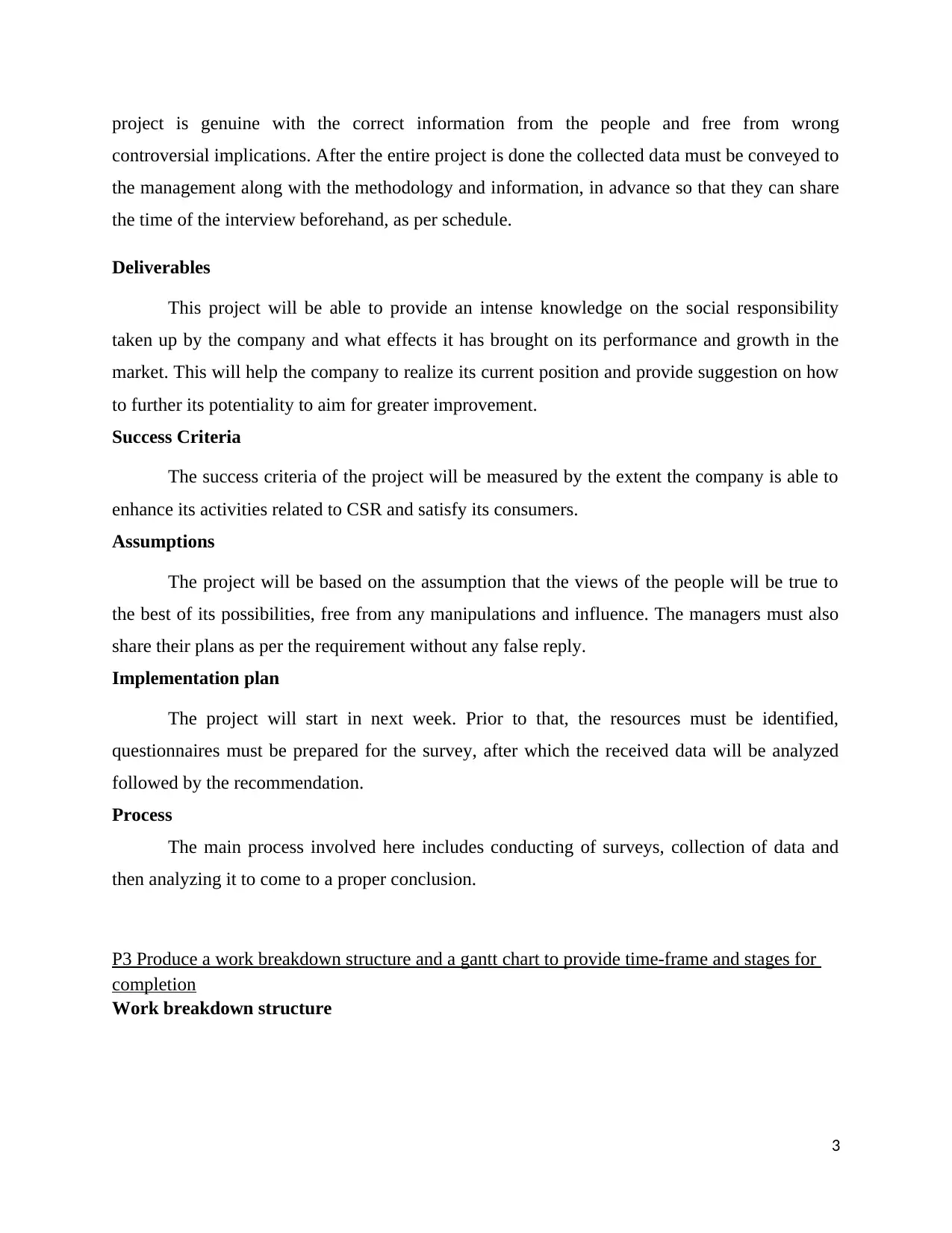
project is genuine with the correct information from the people and free from wrong
controversial implications. After the entire project is done the collected data must be conveyed to
the management along with the methodology and information, in advance so that they can share
the time of the interview beforehand, as per schedule.
Deliverables
This project will be able to provide an intense knowledge on the social responsibility
taken up by the company and what effects it has brought on its performance and growth in the
market. This will help the company to realize its current position and provide suggestion on how
to further its potentiality to aim for greater improvement.
Success Criteria
The success criteria of the project will be measured by the extent the company is able to
enhance its activities related to CSR and satisfy its consumers.
Assumptions
The project will be based on the assumption that the views of the people will be true to
the best of its possibilities, free from any manipulations and influence. The managers must also
share their plans as per the requirement without any false reply.
Implementation plan
The project will start in next week. Prior to that, the resources must be identified,
questionnaires must be prepared for the survey, after which the received data will be analyzed
followed by the recommendation.
Process
The main process involved here includes conducting of surveys, collection of data and
then analyzing it to come to a proper conclusion.
P3 Produce a work breakdown structure and a gantt chart to provide time-frame and stages for
completion
Work breakdown structure
3
controversial implications. After the entire project is done the collected data must be conveyed to
the management along with the methodology and information, in advance so that they can share
the time of the interview beforehand, as per schedule.
Deliverables
This project will be able to provide an intense knowledge on the social responsibility
taken up by the company and what effects it has brought on its performance and growth in the
market. This will help the company to realize its current position and provide suggestion on how
to further its potentiality to aim for greater improvement.
Success Criteria
The success criteria of the project will be measured by the extent the company is able to
enhance its activities related to CSR and satisfy its consumers.
Assumptions
The project will be based on the assumption that the views of the people will be true to
the best of its possibilities, free from any manipulations and influence. The managers must also
share their plans as per the requirement without any false reply.
Implementation plan
The project will start in next week. Prior to that, the resources must be identified,
questionnaires must be prepared for the survey, after which the received data will be analyzed
followed by the recommendation.
Process
The main process involved here includes conducting of surveys, collection of data and
then analyzing it to come to a proper conclusion.
P3 Produce a work breakdown structure and a gantt chart to provide time-frame and stages for
completion
Work breakdown structure
3
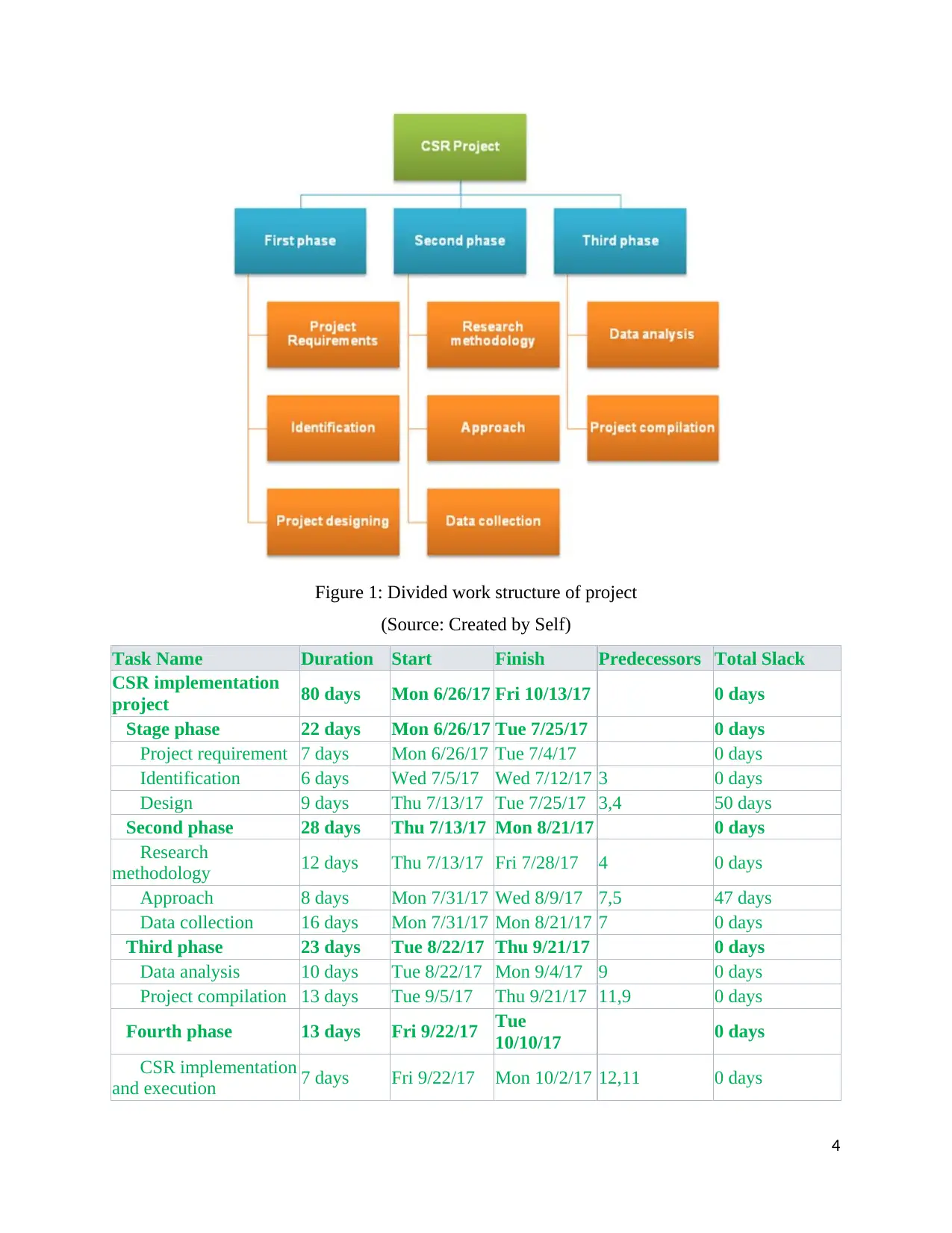
Figure 1: Divided work structure of project
(Source: Created by Self)
Task Name Duration Start Finish Predecessors Total Slack
CSR implementation
project 80 days Mon 6/26/17 Fri 10/13/17 0 days
Stage phase 22 days Mon 6/26/17 Tue 7/25/17 0 days
Project requirement 7 days Mon 6/26/17 Tue 7/4/17 0 days
Identification 6 days Wed 7/5/17 Wed 7/12/17 3 0 days
Design 9 days Thu 7/13/17 Tue 7/25/17 3,4 50 days
Second phase 28 days Thu 7/13/17 Mon 8/21/17 0 days
Research
methodology 12 days Thu 7/13/17 Fri 7/28/17 4 0 days
Approach 8 days Mon 7/31/17 Wed 8/9/17 7,5 47 days
Data collection 16 days Mon 7/31/17 Mon 8/21/17 7 0 days
Third phase 23 days Tue 8/22/17 Thu 9/21/17 0 days
Data analysis 10 days Tue 8/22/17 Mon 9/4/17 9 0 days
Project compilation 13 days Tue 9/5/17 Thu 9/21/17 11,9 0 days
Fourth phase 13 days Fri 9/22/17 Tue
10/10/17 0 days
CSR implementation
and execution 7 days Fri 9/22/17 Mon 10/2/17 12,11 0 days
4
(Source: Created by Self)
Task Name Duration Start Finish Predecessors Total Slack
CSR implementation
project 80 days Mon 6/26/17 Fri 10/13/17 0 days
Stage phase 22 days Mon 6/26/17 Tue 7/25/17 0 days
Project requirement 7 days Mon 6/26/17 Tue 7/4/17 0 days
Identification 6 days Wed 7/5/17 Wed 7/12/17 3 0 days
Design 9 days Thu 7/13/17 Tue 7/25/17 3,4 50 days
Second phase 28 days Thu 7/13/17 Mon 8/21/17 0 days
Research
methodology 12 days Thu 7/13/17 Fri 7/28/17 4 0 days
Approach 8 days Mon 7/31/17 Wed 8/9/17 7,5 47 days
Data collection 16 days Mon 7/31/17 Mon 8/21/17 7 0 days
Third phase 23 days Tue 8/22/17 Thu 9/21/17 0 days
Data analysis 10 days Tue 8/22/17 Mon 9/4/17 9 0 days
Project compilation 13 days Tue 9/5/17 Thu 9/21/17 11,9 0 days
Fourth phase 13 days Fri 9/22/17 Tue
10/10/17 0 days
CSR implementation
and execution 7 days Fri 9/22/17 Mon 10/2/17 12,11 0 days
4
⊘ This is a preview!⊘
Do you want full access?
Subscribe today to unlock all pages.

Trusted by 1+ million students worldwide
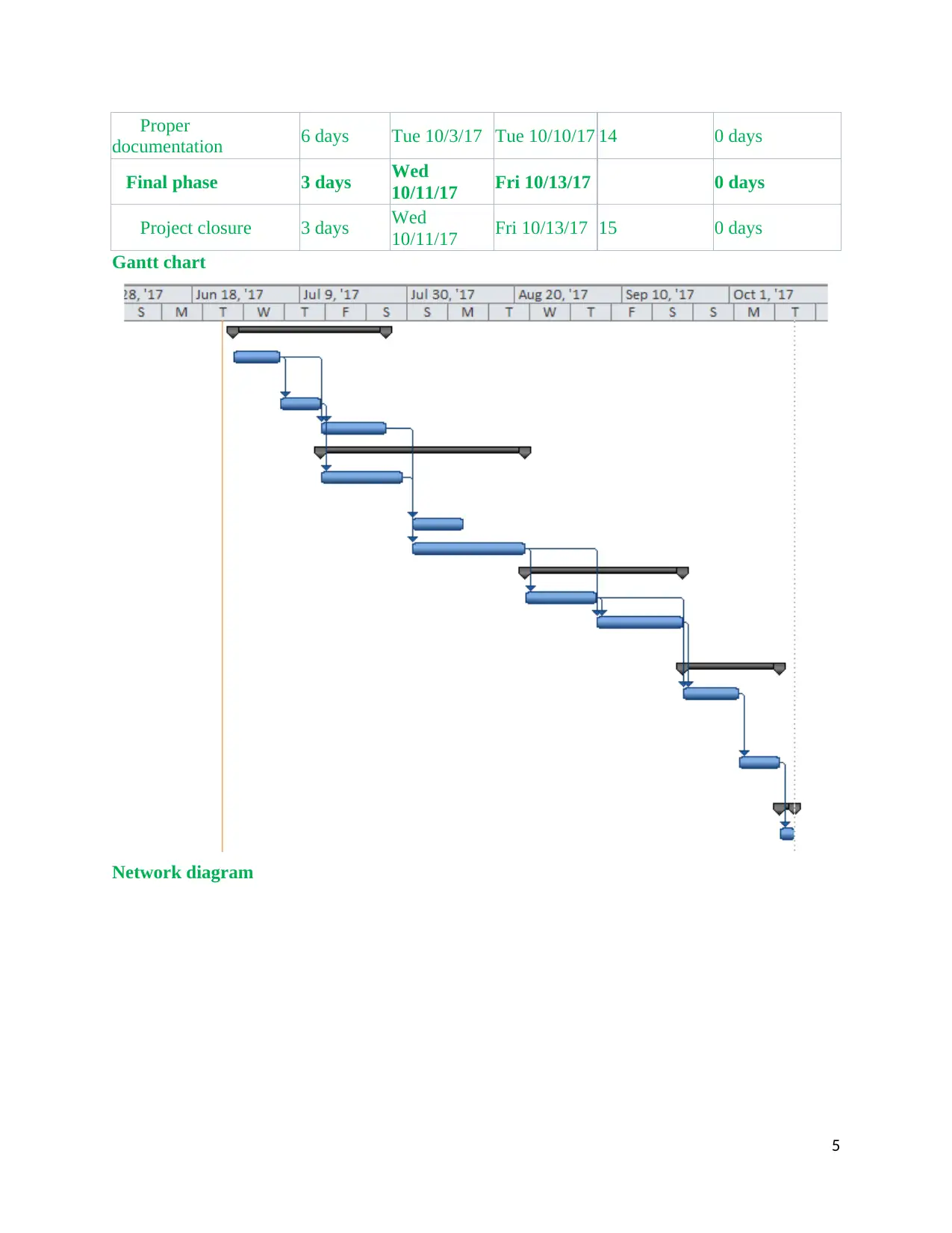
Proper
documentation 6 days Tue 10/3/17 Tue 10/10/17 14 0 days
Final phase 3 days Wed
10/11/17 Fri 10/13/17 0 days
Project closure 3 days Wed
10/11/17 Fri 10/13/17 15 0 days
Gantt chart
Network diagram
5
documentation 6 days Tue 10/3/17 Tue 10/10/17 14 0 days
Final phase 3 days Wed
10/11/17 Fri 10/13/17 0 days
Project closure 3 days Wed
10/11/17 Fri 10/13/17 15 0 days
Gantt chart
Network diagram
5
Paraphrase This Document
Need a fresh take? Get an instant paraphrase of this document with our AI Paraphraser
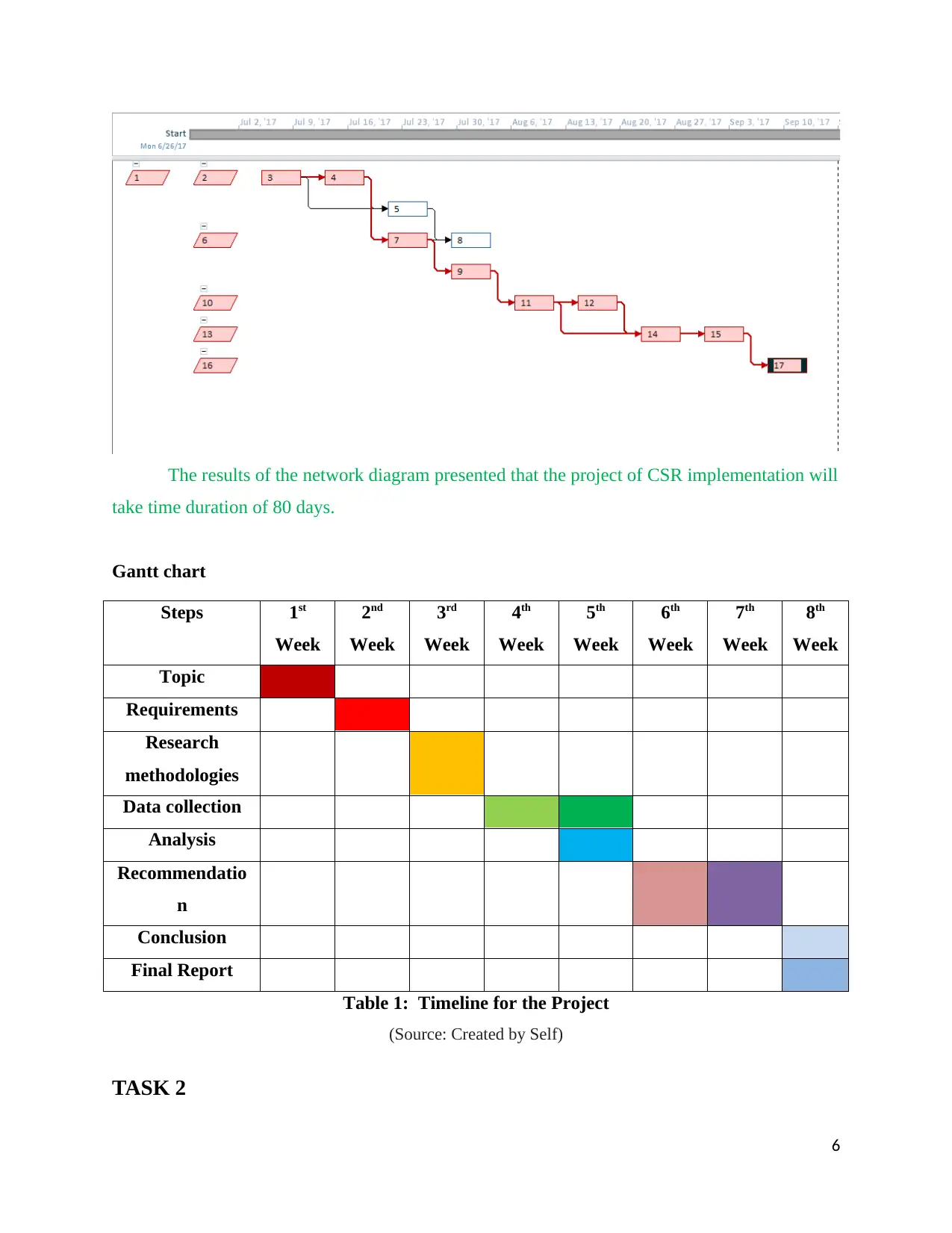
The results of the network diagram presented that the project of CSR implementation will
take time duration of 80 days.
Gantt chart
Steps 1st
Week
2nd
Week
3rd
Week
4th
Week
5th
Week
6th
Week
7th
Week
8th
Week
Topic
Requirements
Research
methodologies
Data collection
Analysis
Recommendatio
n
Conclusion
Final Report
Table 1: Timeline for the Project
(Source: Created by Self)
TASK 2
6
take time duration of 80 days.
Gantt chart
Steps 1st
Week
2nd
Week
3rd
Week
4th
Week
5th
Week
6th
Week
7th
Week
8th
Week
Topic
Requirements
Research
methodologies
Data collection
Analysis
Recommendatio
n
Conclusion
Final Report
Table 1: Timeline for the Project
(Source: Created by Self)
TASK 2
6
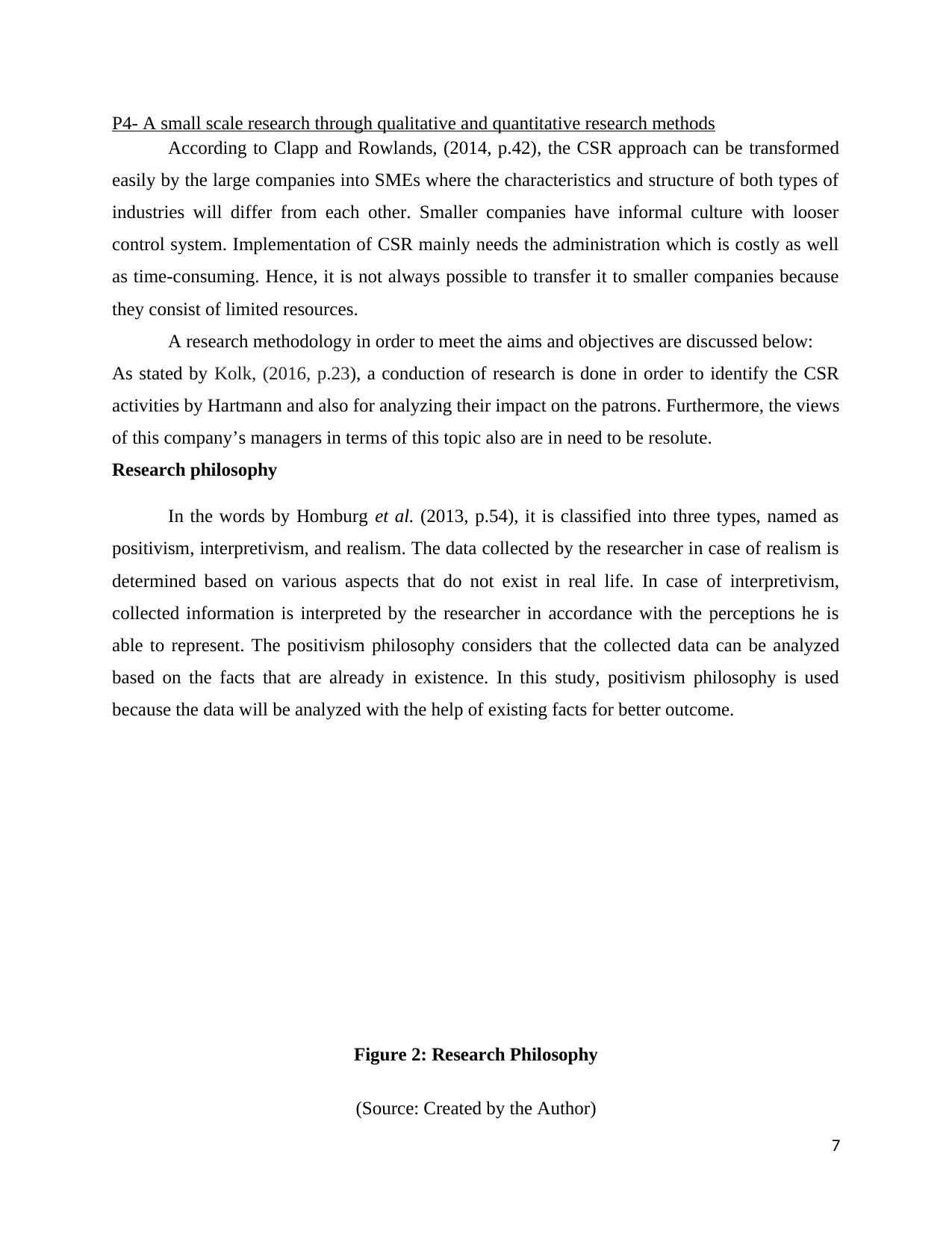
P4- A small scale research through qualitative and quantitative research methods
According to Clapp and Rowlands, (2014, p.42), the CSR approach can be transformed
easily by the large companies into SMEs where the characteristics and structure of both types of
industries will differ from each other. Smaller companies have informal culture with looser
control system. Implementation of CSR mainly needs the administration which is costly as well
as time-consuming. Hence, it is not always possible to transfer it to smaller companies because
they consist of limited resources.
A research methodology in order to meet the aims and objectives are discussed below:
As stated by Kolk, (2016, p.23), a conduction of research is done in order to identify the CSR
activities by Hartmann and also for analyzing their impact on the patrons. Furthermore, the views
of this company’s managers in terms of this topic also are in need to be resolute.
Research philosophy
In the words by Homburg et al. (2013, p.54), it is classified into three types, named as
positivism, interpretivism, and realism. The data collected by the researcher in case of realism is
determined based on various aspects that do not exist in real life. In case of interpretivism,
collected information is interpreted by the researcher in accordance with the perceptions he is
able to represent. The positivism philosophy considers that the collected data can be analyzed
based on the facts that are already in existence. In this study, positivism philosophy is used
because the data will be analyzed with the help of existing facts for better outcome.
Figure 2: Research Philosophy
(Source: Created by the Author)
7
Positivism
According to Clapp and Rowlands, (2014, p.42), the CSR approach can be transformed
easily by the large companies into SMEs where the characteristics and structure of both types of
industries will differ from each other. Smaller companies have informal culture with looser
control system. Implementation of CSR mainly needs the administration which is costly as well
as time-consuming. Hence, it is not always possible to transfer it to smaller companies because
they consist of limited resources.
A research methodology in order to meet the aims and objectives are discussed below:
As stated by Kolk, (2016, p.23), a conduction of research is done in order to identify the CSR
activities by Hartmann and also for analyzing their impact on the patrons. Furthermore, the views
of this company’s managers in terms of this topic also are in need to be resolute.
Research philosophy
In the words by Homburg et al. (2013, p.54), it is classified into three types, named as
positivism, interpretivism, and realism. The data collected by the researcher in case of realism is
determined based on various aspects that do not exist in real life. In case of interpretivism,
collected information is interpreted by the researcher in accordance with the perceptions he is
able to represent. The positivism philosophy considers that the collected data can be analyzed
based on the facts that are already in existence. In this study, positivism philosophy is used
because the data will be analyzed with the help of existing facts for better outcome.
Figure 2: Research Philosophy
(Source: Created by the Author)
7
Positivism
⊘ This is a preview!⊘
Do you want full access?
Subscribe today to unlock all pages.

Trusted by 1+ million students worldwide
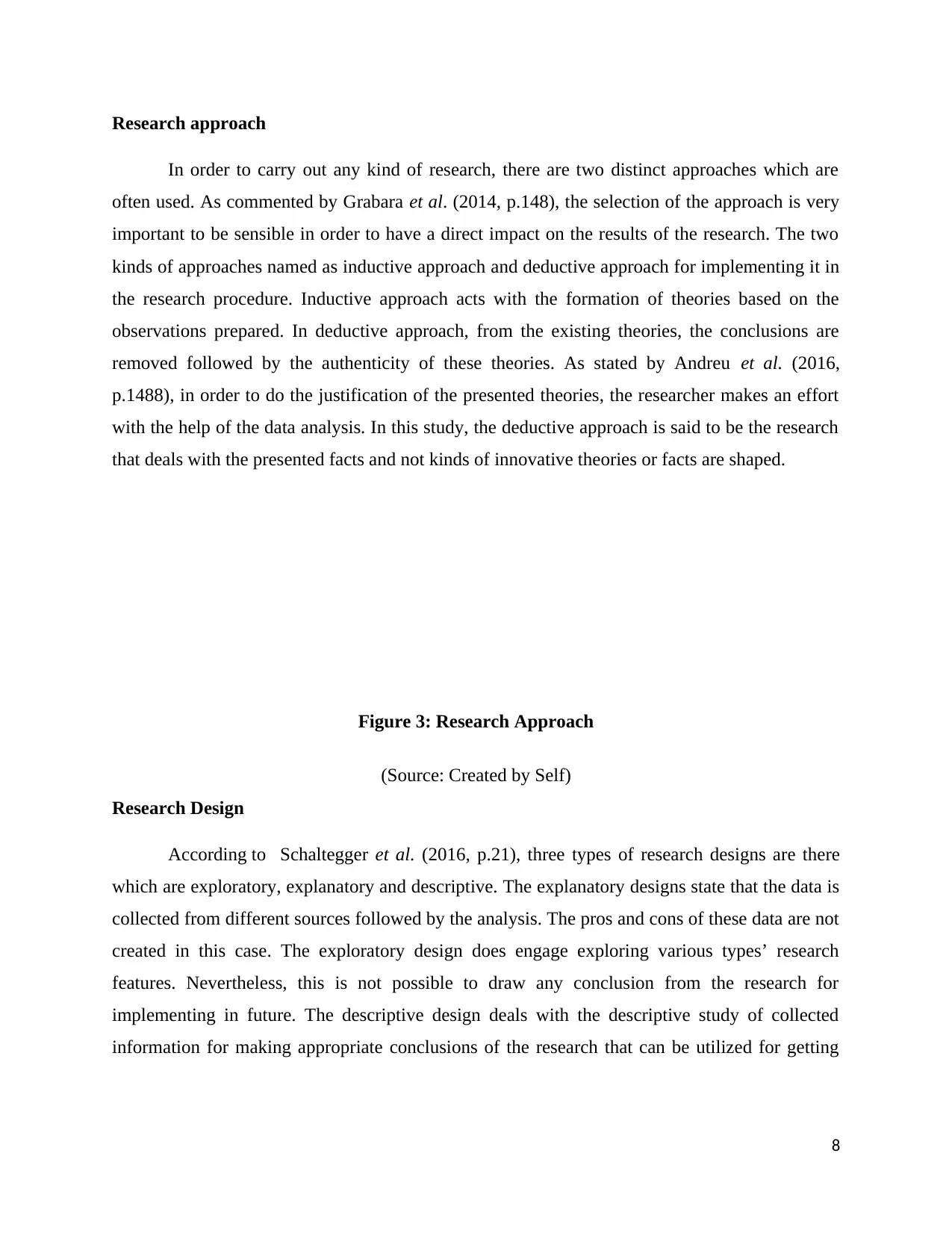
Research approach
In order to carry out any kind of research, there are two distinct approaches which are
often used. As commented by Grabara et al. (2014, p.148), the selection of the approach is very
important to be sensible in order to have a direct impact on the results of the research. The two
kinds of approaches named as inductive approach and deductive approach for implementing it in
the research procedure. Inductive approach acts with the formation of theories based on the
observations prepared. In deductive approach, from the existing theories, the conclusions are
removed followed by the authenticity of these theories. As stated by Andreu et al. (2016,
p.1488), in order to do the justification of the presented theories, the researcher makes an effort
with the help of the data analysis. In this study, the deductive approach is said to be the research
that deals with the presented facts and not kinds of innovative theories or facts are shaped.
Figure 3: Research Approach
(Source: Created by Self)
Research Design
According to Schaltegger et al. (2016, p.21), three types of research designs are there
which are exploratory, explanatory and descriptive. The explanatory designs state that the data is
collected from different sources followed by the analysis. The pros and cons of these data are not
created in this case. The exploratory design does engage exploring various types’ research
features. Nevertheless, this is not possible to draw any conclusion from the research for
implementing in future. The descriptive design deals with the descriptive study of collected
information for making appropriate conclusions of the research that can be utilized for getting
8
InductiveApproachDeductiveApproach
In order to carry out any kind of research, there are two distinct approaches which are
often used. As commented by Grabara et al. (2014, p.148), the selection of the approach is very
important to be sensible in order to have a direct impact on the results of the research. The two
kinds of approaches named as inductive approach and deductive approach for implementing it in
the research procedure. Inductive approach acts with the formation of theories based on the
observations prepared. In deductive approach, from the existing theories, the conclusions are
removed followed by the authenticity of these theories. As stated by Andreu et al. (2016,
p.1488), in order to do the justification of the presented theories, the researcher makes an effort
with the help of the data analysis. In this study, the deductive approach is said to be the research
that deals with the presented facts and not kinds of innovative theories or facts are shaped.
Figure 3: Research Approach
(Source: Created by Self)
Research Design
According to Schaltegger et al. (2016, p.21), three types of research designs are there
which are exploratory, explanatory and descriptive. The explanatory designs state that the data is
collected from different sources followed by the analysis. The pros and cons of these data are not
created in this case. The exploratory design does engage exploring various types’ research
features. Nevertheless, this is not possible to draw any conclusion from the research for
implementing in future. The descriptive design deals with the descriptive study of collected
information for making appropriate conclusions of the research that can be utilized for getting
8
InductiveApproachDeductiveApproach
Paraphrase This Document
Need a fresh take? Get an instant paraphrase of this document with our AI Paraphraser
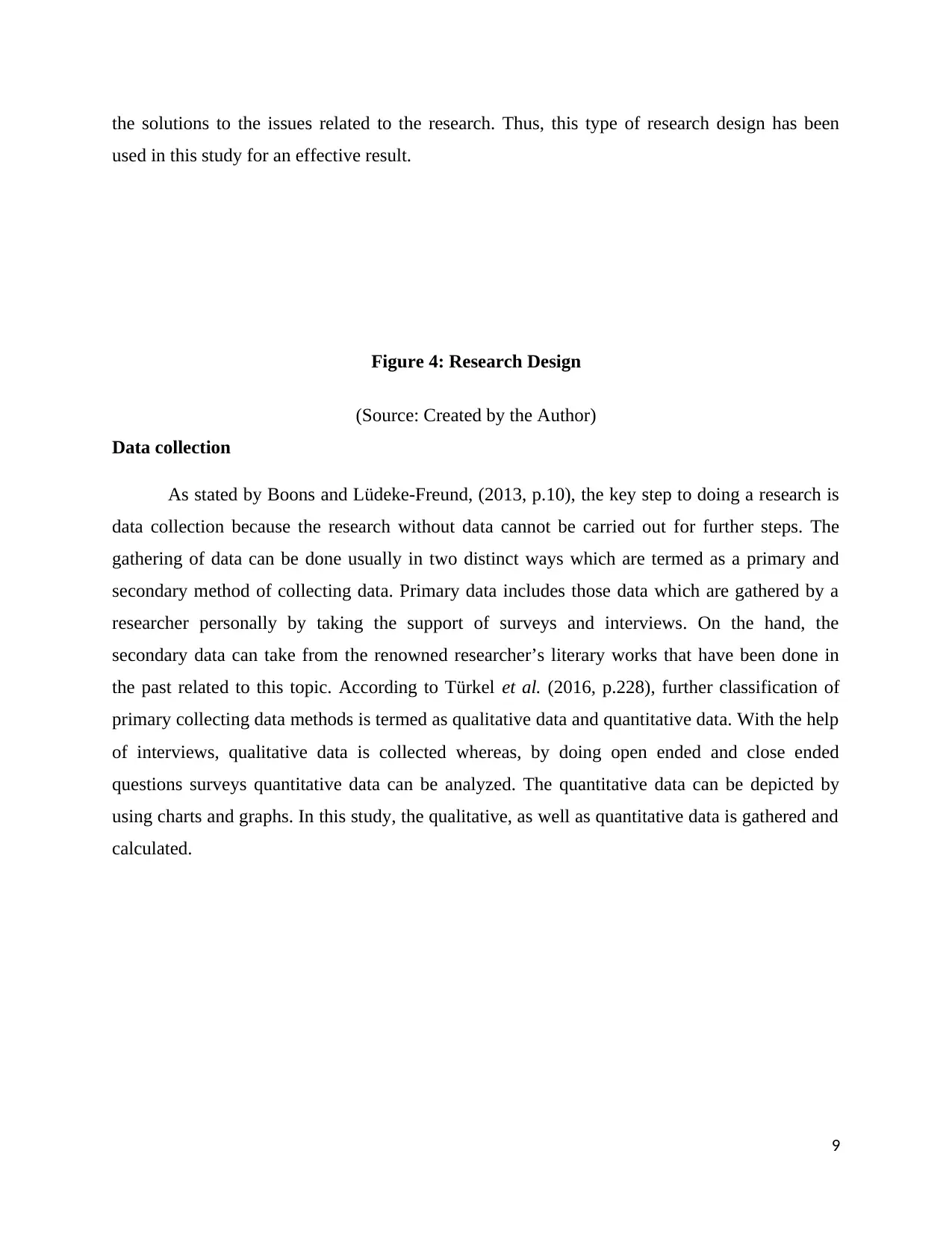
the solutions to the issues related to the research. Thus, this type of research design has been
used in this study for an effective result.
Figure 4: Research Design
(Source: Created by the Author)
Data collection
As stated by Boons and Lüdeke-Freund, (2013, p.10), the key step to doing a research is
data collection because the research without data cannot be carried out for further steps. The
gathering of data can be done usually in two distinct ways which are termed as a primary and
secondary method of collecting data. Primary data includes those data which are gathered by a
researcher personally by taking the support of surveys and interviews. On the hand, the
secondary data can take from the renowned researcher’s literary works that have been done in
the past related to this topic. According to Türkel et al. (2016, p.228), further classification of
primary collecting data methods is termed as qualitative data and quantitative data. With the help
of interviews, qualitative data is collected whereas, by doing open ended and close ended
questions surveys quantitative data can be analyzed. The quantitative data can be depicted by
using charts and graphs. In this study, the qualitative, as well as quantitative data is gathered and
calculated.
9
ExploratoryExplanatoryDescriptive
used in this study for an effective result.
Figure 4: Research Design
(Source: Created by the Author)
Data collection
As stated by Boons and Lüdeke-Freund, (2013, p.10), the key step to doing a research is
data collection because the research without data cannot be carried out for further steps. The
gathering of data can be done usually in two distinct ways which are termed as a primary and
secondary method of collecting data. Primary data includes those data which are gathered by a
researcher personally by taking the support of surveys and interviews. On the hand, the
secondary data can take from the renowned researcher’s literary works that have been done in
the past related to this topic. According to Türkel et al. (2016, p.228), further classification of
primary collecting data methods is termed as qualitative data and quantitative data. With the help
of interviews, qualitative data is collected whereas, by doing open ended and close ended
questions surveys quantitative data can be analyzed. The quantitative data can be depicted by
using charts and graphs. In this study, the qualitative, as well as quantitative data is gathered and
calculated.
9
ExploratoryExplanatoryDescriptive
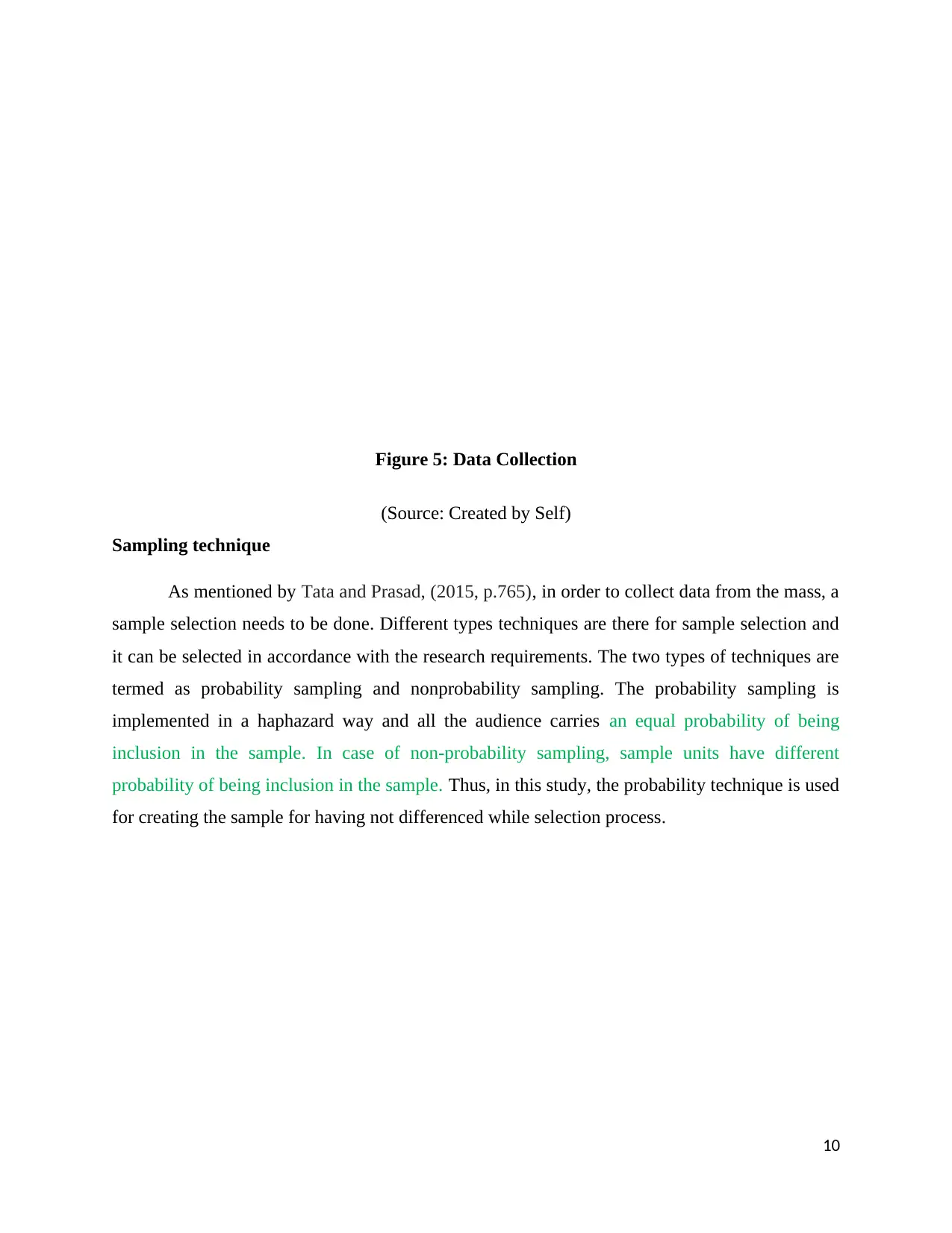
Figure 5: Data Collection
(Source: Created by Self)
Sampling technique
As mentioned by Tata and Prasad, (2015, p.765), in order to collect data from the mass, a
sample selection needs to be done. Different types techniques are there for sample selection and
it can be selected in accordance with the research requirements. The two types of techniques are
termed as probability sampling and nonprobability sampling. The probability sampling is
implemented in a haphazard way and all the audience carries an equal probability of being
inclusion in the sample. In case of non-probability sampling, sample units have different
probability of being inclusion in the sample. Thus, in this study, the probability technique is used
for creating the sample for having not differenced while selection process.
10
PrimaryDataSecondaryData
(Source: Created by Self)
Sampling technique
As mentioned by Tata and Prasad, (2015, p.765), in order to collect data from the mass, a
sample selection needs to be done. Different types techniques are there for sample selection and
it can be selected in accordance with the research requirements. The two types of techniques are
termed as probability sampling and nonprobability sampling. The probability sampling is
implemented in a haphazard way and all the audience carries an equal probability of being
inclusion in the sample. In case of non-probability sampling, sample units have different
probability of being inclusion in the sample. Thus, in this study, the probability technique is used
for creating the sample for having not differenced while selection process.
10
PrimaryDataSecondaryData
⊘ This is a preview!⊘
Do you want full access?
Subscribe today to unlock all pages.

Trusted by 1+ million students worldwide
1 out of 22
Related Documents
Your All-in-One AI-Powered Toolkit for Academic Success.
+13062052269
info@desklib.com
Available 24*7 on WhatsApp / Email
![[object Object]](/_next/static/media/star-bottom.7253800d.svg)
Unlock your academic potential
Copyright © 2020–2025 A2Z Services. All Rights Reserved. Developed and managed by ZUCOL.





